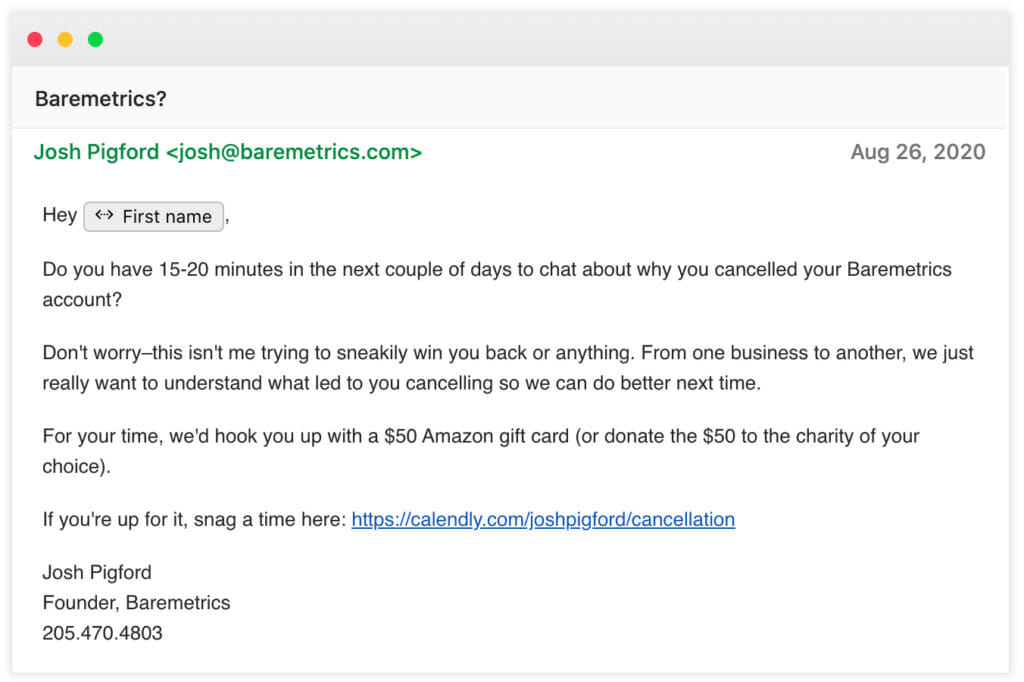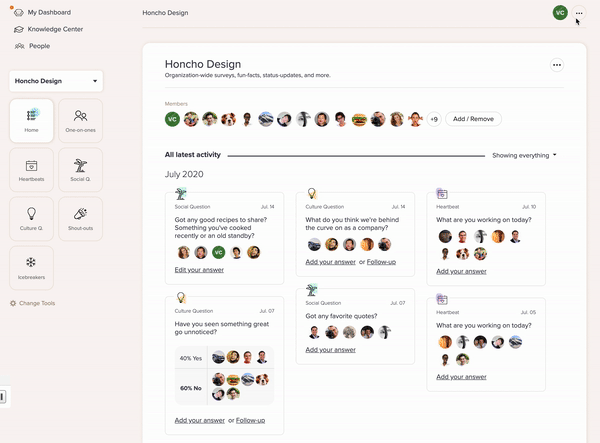Customer onboarding flows get all the love. Figuring out how to get more users to important milestones, find value, and integrate into their workflow is exciting stuff (for SaaS nerds like us).
But you know what doesn’t get any love? Customer offboarding: all the steps involved in a customer canceling their account and successfully disengaging from the product.
Table of contents
- What is customer offboarding?
- Why having an offboarding flow matters
- Crawl: Basic offboarding patterns your customers won’t hate you for
- Walk: Implementing a professional cancellation experience
- Run: Advanced techniques to capture data and save customers from cancelling
- Bonus: Exit interviews
- Build vs. buy
- Conclusion
What is customer offboarding?
Customer offboarding is the process where a customer cancels their account and stops engaging with your product or brand. The result of your customer offboarding process will be customer churn.
Why having an offboarding flow matters
When was the last time you sat down to think strategically about your customer offboarding flow? I’m going to guess that it’s been a while, maybe even never.
Yet, offboarding is such an important and under-rated opportunity to provide a positive experience that can actually yield advocates, saved customers, and higher retention.
Bad customer offboarding will essentially guarantee you won’t have that customer’s business again. You might even prevent future customers from signing up if they publicly complain.
Take for example, this offboarding flow.
Here’s another example.
Why does Justuno need to collect information like first name, last name, and email address if they already know that information to cancel the account? And why would they need to require consent to contact?
Unnecessary friction is the perfect recipe for creating a negative customer experience.
Through these examples, it’s pretty clear what a bad offboarding UX looks like. But what does good customer offboarding look like?
There are three must-have components to every good customer offboarding flow:
- An easy way to express intent to cancel;
- A process to gather information about the cancellation;
- Follow-up to attempt to win them back as a customer.
In this post, I’ll show you how to create a customer offboarding flow fit for your needs. You can “crawl” to get a minimum viable offboarding flow off the ground, “walk” to create a professional flow that automatically collects insights, or “run” to design a process that prevents churn and reactivates cancelled customers.
Crawl: Basic offboarding patterns your customers won’t hate you for
At a minimum, you’ll want to provide a way for customers to cancel their account as well as a way to follow-up for feedback about why they cancelled.
Thankfully, technology like Stripe’s customer portal and Servicebot make it incredibly easy to allow customers to manage their subscriptions.
An enormous number of SaaS businesses use Stripe to bill customers, and with their new customer portal, it’s easier than ever to get something in place without having to spend weeks coding up your own page.
Servicebot also offers a no-code customer portal along with several other notable features that make it easy to go from 0 to 1.

Regardless of which billing platform you use, the first step is to start collecting feedback on why customers cancel.
There’s no need to over-engineer it: Groove started sending out a simple email that asks users to reply with why they cancelled.

Here’s what Groove CEO Alex Turnbull said about how that email performed:
Not only was the response rate nearly eight times greater at 10.2%, but we were finally starting to get real, actionable data. Specific bugs that our active customers weren’t telling us about. Hang-ups in our user experience that we didn’t catch. Workflow inefficiencies for use cases that we had never considered. Now we were getting somewhere. Takeaway: By removing the pre-filled answers in our exit survey, we were able to unlock loads of valuable — and actionable — data.
Here’s an another example from Pat Walls, founder of Pigeon. He sends out a personal email to all customers that cancel to ask for feedback.

Short, clear and simple.
This approach works well in the early stages of your SaaS company. But as your business grows, you’ll want a more scalable and efficient way to find out why customers are churning.
Walk: Implementing a professional cancellation experience
Going beyond the bare minimum, a professional cancellation experience is going to require a few additional ingredients:
- A cancellation survey that allows users to select a reason or write in their own reason;
- An automated email that follows up on their survey response to get additional information.
An open-text field or email reply are great ways to collect feedback in the beginning, but eventually you’ll want to upgrade to a cancellation survey.
A cancellation survey is a much more sustainable way to collect feedback long-term as it allows you to categorize into broader reasons and trends.
There are a few different ways to create a cancellation survey. It’s not uncommon to use tools like Google Forms, Wufoo, Jotform, or Typeform.

If you go this route, what you’ll do is create the survey and then either send the link to users after they cancel or, if your tech stack allows, embed the form on your billing or cancellation page.
The benefit of this method is it’s free. The downside is “free” usually comes with some restrictions like less customization and you’ll likely have to do some manual work to connect your survey results to the rest of your subscription data.
It’s usually best to keep the survey as short as possible, so asking just 1-2 questions is all that’s required to help you answer the question, “What are the reasons customers are cancelling?”
For instance, Usersnap took the small step of adding a field in their unsubscribe page for users to tell them why they want to cancel. After collecting some responses, they spotted a common trend.

Customers only saw a one-time need for their product, which limited their customer lifetime value and resulted in fast churn.
Usersnap took that feedback and created a new product line that gave users a reason to stick around longer. The result was more long term customers and lower churn.
Another method, which I’d recommend, is to use a tool specifically for SaaS cancellations. (Full disclosure, we actually built one at Baremetrics, but there are other tools out there that can help. If you have the resources, you can even build one yourself.)
To give you an idea of how it works, you first create a form where users can choose their cancellation reason.
You then send the survey through email, which looks like this.
Or even embed the form on your cancellation page.

Wobaka has a great example of what a great cancellation survey looks like.
Algolia is another great example of a simple, professional cancellation process.
You can even automate your cancellation survey using a tool such as Zapier. For example, in this workflow, Zapier will automatically send an exit survey feedback when the membership is changed to canceled.

Regardless of the actual setup, having a cancellation survey and automated email set up allows you to collect feedback at scale that you can organize, compare, and synthesize into actionable changes. Your cancelation survey is only as valuable as the data you collect and execute on.
Run: Advanced techniques to capture data and save customers from cancelling
To get really sophisticated, you can architect a multi-step customer offboarding flow. But this is where we enter dangerous territory. We don’t want to end up something like what the Dave app customer complained publicly about, do we?
It’s a delicate balancing act between asking enough questions to collect the valuable insights you need to improve retention and keeping it short enough so as to get a high completion rate without irritating customers.
The benefits of a multi-step process is that you can collect more contextual data on why customers are cancelling and then even create opportunities to prevent a customer from cancelling altogether.
Being able to save a churning customer is the holy grail of retention.
I recommend playing it on the safe side and designing a minimally viable customer offboarding flow. What’s the least number of steps you need to capture more information and attempt to save a churning customer?
A good place to start is to create steps around four components:
- Select reason;
- Followup question about reason;
- Personalized offer;
- Are you sure?
We recommend using a multiple choice survey to select a reason for why they’re cancelling rather than an open-text comment box for a few reasons:
- It allows you easily categorize reasons when visualizing trends;
- You can then ask an additional question based on which reason they selected to dig deeper into why they selected that reason;
- You can also create a personalized offer to save them from churning based on which reason they selected.
If you’re starting from scratch, here are the boilerplate reasons you can display to customers
- [ ] Technical issues;
- [ ] Too expensive;
- [ ] Switching to another product;
- [ ] Not sure how to use the product;
- [ ] Missing features;
- [ ] Other (please explain below).
As time goes, you can adjust the reasons displayed based on the data you collect.
Flywheel created a slick multi-step survey in the offboarding flow that allows them to collect granular insights on the exact reasons customers are cancelling.
Notice how they have an additional multiple choice survey based on which high-level reason a customer selected for why they’re cancelling. They also have an open-text comment box that collects additional information based on the detailed reason selected in the second step.
It’s slightly more complex, but balances the need for valuable insights and not upsetting a customer who is deciding to take their business elsewhere.
ZenMaid implemented Raaft to create a custom offboarding flow that surveys customers about why they’re cancelling and then makes a personalized offer to try to prevent them from cancelling.
Bonus: Exit interviews
If you have high ACV customers (5-7 figures annually) or are focusing on customer success, another great addition is to include exit interviews into the normal offboarding flow.
When a customer cancels and completes the offboarding flow, including a cancellation survey, you’ll have good information to work with so you can reach out with a personalized message to schedule an exit interview.
Some companies require an exit interview as a step in the offboarding flow, though we recommend keeping it an optional step that’s presented to the customer as a way for the company to learn how they can improve their products and services. Remember, the last thing you want is to annoy or upset a customer further.
Exit interviews can be conducted over a phone or video call so you can have a conversation to get deeper insights than you’d be able to with a survey.
The goal is to build on the information you already have. You can ask:
- Why did you cancel the day that you cancelled? Why that day, and not the day before or after?
- When was the first time you had the first thought that maybe [PRODUCT] wasn’t going to work? Or realized that you weren’t using it?
- What suggestions do you have for improving the product or service?
- What would it take for you to reconsider subscribing to [PRODUCT]?
- What would’ve prevented you from leaving?
- What could we have done differently?
Before Baremetrics had hundreds of customers and eventually replaced this with Cancellation Insights, we sent a simple email asking customers to do an optional exit interview.

Generally, if you have a low ACV (2-4 figures annually), an email sequence to collect data and then make offers to reactivate users is another good option.
Tools like Intercom and Customer.io are purpose-built for use cases like this, though even a Zapier automation can get the job done.
Here’s an example of a successful campaign from how we did things at Baremetrics a few years ago.
First, we’d make a simple offer to get access to a premium feature in exchange for reactivating.

If there was still no response, we’d email again with an additional offer to get 1-on-1 help with someone on the team.
Build vs. buy
When does it make sense to build your own custom offboarding flow (or parts of it) rather than use plug-and-play, off-the-shelf tools?
Building it yourself provides an unmatched amount of flexibility, control, and customization. If you plan on doing A/B testing to see if certain offboarding flow variations yield better results, iterating over time, or piping the data over to other internal tools, there’s no better long-term solution than to handle it in-house.
If you have the time and resources to devote to creating a custom offboarding flow yourself, it’s definitely a viable option.
But like everything in business, there are trade-offs.
Using a third-party tool usually allows you to bypass doing much of the heavy lifting yourself by providing pre-built integrations, native visualizations, data crunching, and automations.
For example, when the user chooses their cancellation reason through our tool, it saves to their account profile in Baremetrics. So you can see exactly when and why each customer cancels.

It also aggregates all the data from the survey so you can see which cancellation reasons are most common, and which cost you the most revenue.
After the customer selects their cancellation reason, you can create a follow-up email to send based on their response.
And you can track when (or if) they open the email.
What’s the opportunity cost of spending time and resources building an offboarding flow in-house when that time and resources can be spent building elsewhere? On the flip side, letting a third-party tool handle something saves time, but ultimately sacrifices customization and flexibility.
Conclusion
Your customer offboarding flow is such a critical component to being able to improve retention that often gets overlooked.
Based on your stage of business and how sophisticated you want to get, now you can create an offboarding flow that won’t make customers angry, and may even delight them!














